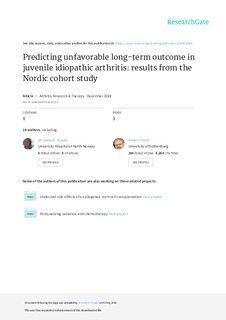| dc.contributor.author | Rypdal, Veronika Gjertsen | |
| dc.contributor.author | Arnstad, Ellen Dalen | |
| dc.contributor.author | Aalto, Kristiina | |
| dc.contributor.author | Berntson, Lillemor | |
| dc.contributor.author | Ekelund, Maria | |
| dc.contributor.author | Fasth, Anders | |
| dc.contributor.author | Glerup, Mia | |
| dc.contributor.author | Herlin, Troels | |
| dc.contributor.author | Nielsen, Susan | |
| dc.contributor.author | Peltoniemi, Suvi | |
| dc.contributor.author | Zak, Marek | |
| dc.contributor.author | Rygg, Marite | |
| dc.contributor.author | Rypdal, Martin Wibe | |
| dc.contributor.author | Nordal, Ellen Berit | |
| dc.date.accessioned | 2019-03-01T09:37:39Z | |
| dc.date.available | 2019-03-01T09:37:39Z | |
| dc.date.created | 2018-06-21T10:00:49Z | |
| dc.date.issued | 2018 | |
| dc.identifier.issn | 1478-6362 | |
| dc.identifier.uri | http://hdl.handle.net/11250/2588207 | |
| dc.description.abstract | Background
The aim was to develop prediction rules that may guide early treatment decisions based on baseline clinical predictors of long-term unfavorable outcome in juvenile idiopathic arthritis (JIA).
Methods
In the Nordic JIA cohort, we assessed baseline disease characteristics as predictors of the following outcomes 8 years after disease onset. Non-achievement of remission off medication according to the preliminary Wallace criteria, functional disability assessed by Childhood Health Assessment Questionnaire (CHAQ) and Physical Summary Score (PhS) of the Child Health Questionnaire, and articular damage assessed by the Juvenile Arthritis Damage Index-Articular (JADI-A). Multivariable models were constructed, and cross-validations were performed by repeated partitioning of the cohort into training sets for developing prediction models and validation sets to test predictive ability.
Results
The total cohort constituted 423 children. Remission status was available in 410 children: 244 (59.5%) of these did not achieve remission off medication at the final study visit. Functional disability was present in 111/340 (32.7%) children assessed by CHAQ and 40/199 (20.1%) by PhS, and joint damage was found in 29/216 (13.4%). Model performance was acceptable for making predictions of long-term outcome. In validation sets, the area under the curves (AUCs) in the receiver operating characteristic (ROC) curves were 0.78 (IQR 0.72–0.82) for non-achievement of remission off medication, 0.73 (IQR 0.67–0.76) for functional disability assessed by CHAQ, 0.74 (IQR 0.65–0.80) for functional disability assessed by PhS, and 0.73 (IQR 0.63–0.76) for joint damage using JADI-A.
Conclusion
The feasibility of making long-term predictions of JIA outcome based on early clinical assessment is demonstrated. The prediction models have acceptable precision and require only readily available baseline variables. Further testing in other cohorts is warranted. | nb_NO |
| dc.language.iso | eng | nb_NO |
| dc.publisher | BMC (part of Springer Nature) | nb_NO |
| dc.rights | Navngivelse 4.0 Internasjonal | * |
| dc.rights.uri | http://creativecommons.org/licenses/by/4.0/deed.no | * |
| dc.title | Predicting unfavorable long-term outcome in juvenile idiopathic arthritis: Results from the Nordic cohort study | nb_NO |
| dc.type | Journal article | nb_NO |
| dc.type | Peer reviewed | nb_NO |
| dc.description.version | publishedVersion | nb_NO |
| dc.source.volume | 20 | nb_NO |
| dc.source.journal | Arthritis Research & Therapy | nb_NO |
| dc.source.issue | 91 | nb_NO |
| dc.identifier.doi | 10.1186/s13075-018-1571-6 | |
| dc.identifier.cristin | 1592822 | |
| dc.description.localcode | © The Author(s). 2018 Open Access This article is distributed under the terms of the Creative Commons Attribution 4.0 International License (http://creativecommons.org/licenses/by/4.0/) | nb_NO |
| cristin.unitcode | 194,65,15,0 | |
| cristin.unitname | Institutt for klinisk og molekylær medisin | |
| cristin.ispublished | true | |
| cristin.fulltext | original | |
| cristin.qualitycode | 2 | |

